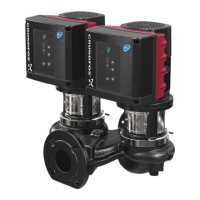39
English (US)
15.19 General settings
15.19.1 Language
A number of languages is available.
Measuring units are automatically changed according to selected
language.
15.19.2 Units
In this menu you can select between US and SI units. The setting
can be made generally for all parameters or customized for each
individual parameter.
15.19.3 Enable/disable settings
In this display, you can disable the possibility of making settings
for protective reasons.
15.19.4 Delete history
In this menu you can delete the following historic data:
• Delete work log.
• Delete heat energy data.
• Delete energy consumption.
15.19.5 Define Home display
In this menu you can select whether the "Home" display should
show various user-defined parameters or a graphical illustration
of a performance curve with the actual duty point of the pump.
15.19.6 Display settings
In this menu you can adjust the display brightness and define
whether or not the display should turn off if no buttons have been
activated for a period of time.
15.19.7 Store actual settings
In this menu you can store the actual settings for later use.
15.19.8 Recall stored settings
In this menu you can recall the last stored settings that the pump
will then use.
15.19.9 Run startup guide
The startup guide will guide you through the general settings of
the pump.
16. Assist
16.1 Multi-pump setup
The multipump function enables the control of single-head pumps
connected in parallel or twin-head pumps without the use of
external controllers. The pumps in a multipump system
communicate with each other via the wireless GENIair connection
or the wired GENI connection.
You set up a multipump system via a selected pump, i.e. the
master pump (first selected pump). You can connect all Grundfos
pumps with a wireless GENIair connection to the multipump
system.
The multipump functions are described in the following sections.
16.1.1 Alternating operation
Only one pump is operating at a time.
The change from one pump to the other depends on time or
energy. If a pump fails, the other pump will take over
automatically.
Pump system:
• Twin-head pump.
• Two single-head pumps connected in parallel.
The pumps must be of the same type and size. Each pump
requires a non-return valve in series with the pump.
16.1.2 Backup operation
One pump is operating continuously. The backup pump is
operated at intervals to prevent seizing up. If the duty pump stops
due to a fault, the backup pump will start automatically.
Pump system:
• Twin-head pump.
• Two single-head pumps connected in parallel.
The pumps must be of the same type and size. Each pump
requires a non-return valve in series with the pump.
16.1.3 Cascade operation
Cascade operation ensures that the pump performance is
automatically adapted to the consumption by switching pumps on
or off. The system thus runs as energy-efficiently as possible with
a constant pressure and a limited number of pumps.
When a twin-head pump is running in constant-pressure control
mode, the second pump head will start at 90 % and stop at 50 %
performance.
All pumps in operation will run at equal speed. Pump changeover
is automatic and depends on energy, operating hours and fault.
Pump system:
• Twin-head pump.
• Two to four single-head pumps connected in parallel.
The pumps must be of the same type and size. Each pump
requires a non-return valve in series with the pump.
• The control mode must be set to "Const. pressure" or "Const.
curve".
Pump variant General settings
TPE3 (D) ●
TPE2 (D) ●
To unlock the pump and allow settings, press
and simultaneously for at least 5 seconds.
Pump variant Multi-pump setup
TPE3 (D) ●
TPE2 (D) ●

